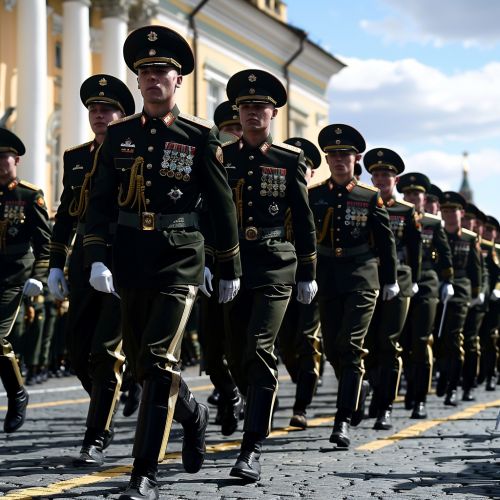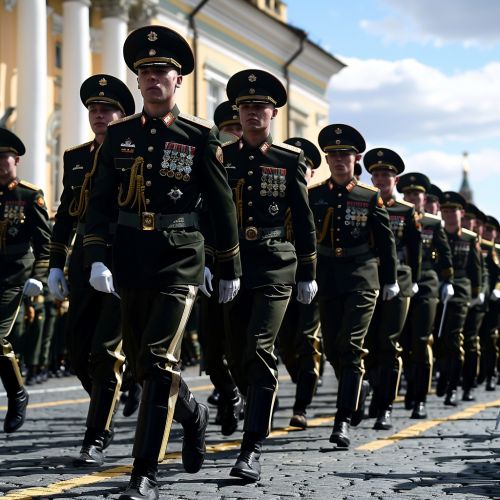Russian military: Difference between revisions
(Created page with "== History == The Russian military, formally known as the Armed Forces of the Russian Federation, has a long and complex history that dates back to the early medieval period. The origins of the Russian military can be traced to the Kievan Rus', a federation of Slavic tribes under the rule of the Varangians. The military structure during this period was characterized by a mix of tribal levies and professional warriors known as the Druzhina. === Tsardom of Russia === Th...") |
No edit summary |
||
| Line 11: | Line 11: | ||
Under Peter the Great, the Russian military underwent extensive reforms. Peter's efforts to modernize the military included the establishment of the Russian Navy, the creation of new regiments, and the introduction of conscription. The military successes during this period, such as the victory in the Great Northern War, established Russia as a major European power. | Under Peter the Great, the Russian military underwent extensive reforms. Peter's efforts to modernize the military included the establishment of the Russian Navy, the creation of new regiments, and the introduction of conscription. The military successes during this period, such as the victory in the Great Northern War, established Russia as a major European power. | ||
[[Image:Detail-97201.jpg|thumb|center|Russian military parade with soldiers marching in uniform.|class=only_on_mobile]] | |||
[[Image:Detail-97202.jpg|thumb|center|Russian military parade with soldiers marching in uniform.|class=only_on_desktop]] | |||
=== Soviet Era === | === Soviet Era === | ||
Latest revision as of 07:25, 26 July 2024
History
The Russian military, formally known as the Armed Forces of the Russian Federation, has a long and complex history that dates back to the early medieval period. The origins of the Russian military can be traced to the Kievan Rus', a federation of Slavic tribes under the rule of the Varangians. The military structure during this period was characterized by a mix of tribal levies and professional warriors known as the Druzhina.
Tsardom of Russia
The establishment of the Tsardom of Russia in the 16th century under Ivan IV (Ivan the Terrible) marked a significant transformation in the Russian military. The Streltsy, a corps of musketeers, was established as a standing army. This period also saw the introduction of Western military techniques and the establishment of a centralized command structure.
Imperial Russia
Under Peter the Great, the Russian military underwent extensive reforms. Peter's efforts to modernize the military included the establishment of the Russian Navy, the creation of new regiments, and the introduction of conscription. The military successes during this period, such as the victory in the Great Northern War, established Russia as a major European power.


Soviet Era
The October Revolution of 1917 led to the formation of the Red Army, which played a crucial role in the Russian Civil War. The Soviet military was characterized by its large size, extensive use of conscription, and a focus on heavy industry and mechanization. During World War II, the Soviet Armed Forces were instrumental in the defeat of Nazi Germany, a conflict known in Russia as the Great Patriotic War.
Post-Soviet Era
Following the dissolution of the Soviet Union in 1991, the Russian military faced significant challenges, including budget cuts, reduced manpower, and a decline in morale. However, the 2000s saw a series of reforms aimed at modernizing the armed forces, improving training, and increasing professionalization.
Structure
The Russian military is divided into several branches, each with its own specific roles and responsibilities.
Ground Forces
The Ground Forces are the largest branch of the Russian military and are responsible for land-based military operations. They include various units such as infantry, armor, artillery, and special forces. The Ground Forces are organized into military districts, each responsible for a specific geographic area.
The Russian Navy is tasked with protecting the country's maritime interests. It is divided into several fleets, including the Northern Fleet, the Pacific Fleet, the Baltic Fleet, and the Black Sea Fleet. The Navy operates a range of vessels, from submarines to aircraft carriers.
Aerospace Forces
The Aerospace Forces are responsible for air and space operations. This branch includes the Air Force, the Air Defense Forces, and the Space Forces. Their roles range from air superiority and strategic bombing to missile defense and satellite operations.
Strategic Missile Forces
The Strategic Missile Forces are a separate branch responsible for Russia's intercontinental ballistic missiles (ICBMs). This branch plays a crucial role in the country's nuclear deterrence strategy.
Airborne Troops
The Airborne Troops are an elite branch of the Russian military, specializing in rapid deployment and airborne operations. They are highly trained and equipped for a variety of missions, including special operations and conventional warfare.
Modernization and Reforms
In recent years, the Russian military has undergone significant modernization efforts. These reforms have focused on improving the quality of personnel, upgrading equipment, and enhancing operational capabilities.
Personnel
One of the key aspects of modernization has been the shift towards a more professional military. This includes increasing the number of contract soldiers and reducing reliance on conscripts. Training programs have also been enhanced to improve the skills and readiness of military personnel.
Equipment
The Russian military has invested heavily in new equipment and technology. This includes the development of advanced fighter jets like the Sukhoi Su-57, new main battle tanks such as the T-14 Armata, and modernized naval vessels. Additionally, there has been a focus on improving cyber capabilities and electronic warfare systems.
Operational Capabilities
Reforms have also aimed at improving the operational capabilities of the Russian military. This includes the establishment of rapid reaction forces, enhanced mobility, and improved logistics. Joint exercises with other countries and participation in international peacekeeping missions have also been part of this effort.
Doctrine and Strategy
The military doctrine of the Russian Federation outlines the principles and strategies that guide its military operations. This doctrine is periodically updated to reflect changes in the global security environment.
Defensive Posture
The Russian military doctrine emphasizes a defensive posture, focusing on the protection of national sovereignty and territorial integrity. This includes the use of strategic deterrence, particularly through its nuclear capabilities.
Hybrid Warfare
In recent years, the concept of hybrid warfare has become a significant aspect of Russian military strategy. This approach combines conventional military operations with cyber warfare, information operations, and the use of proxy forces. The aim is to achieve strategic objectives without engaging in full-scale conventional warfare.
Regional Focus
The Russian military places a strong emphasis on regional security, particularly in areas such as Eastern Europe, the Caucasus, and Central Asia. This includes maintaining a significant military presence in these regions and conducting regular exercises to demonstrate capability and resolve.
Challenges and Criticisms
Despite its strengths, the Russian military faces several challenges and criticisms.
Budget Constraints
One of the primary challenges is budget constraints. While the Russian government has increased military spending in recent years, economic challenges and sanctions have limited the available resources. This has impacted the pace and scope of modernization efforts.
Corruption
Corruption within the military and defense industry is another significant issue. This includes problems with procurement, misallocation of funds, and lack of transparency. Efforts to address these issues have been ongoing but remain a challenge.
Demographic Issues
Russia faces demographic challenges that impact military recruitment and retention. A declining population and health issues among the youth have made it difficult to maintain the desired levels of manpower.
Conclusion
The Russian military is a complex and multifaceted institution with a rich history and a significant role in global security. While it has made considerable strides in modernization and reform, it continues to face challenges that impact its effectiveness and capabilities.
